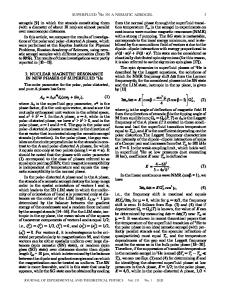Anomalous Heat and Momentum Transport Arising from Surface Roughness in a Normal 3 He Slab
- PDF / 491,561 Bytes
- 9 Pages / 612 x 792 pts (letter) Page_size
- 35 Downloads / 392 Views
S AND LIQUIDS
Anomalous Heat and Momentum Transport Arising from Surface Roughness in a Normal 3He Slab1 P. Sharma Department of Physics, Indian Institute of Science, Bangalore, 560012 India e-mail: [email protected] Received April 19, 2017
Abstract—I discuss heat and momentum transport in a mesoscopic film of 3He, confined by rough walls in the normal Fermi liquid state. Inelastic binary quasiparticle scattering mediated by elastic scattering from the surface roughness gives rise to a coherent “mixed” scattering channel that drives anomalous transport over a range of temperature. I calculate the thermal conductivity and viscosity of the film in this regime and derive these in terms of the film thickness and autocorrelation function of the surface roughness, which enters the formulation as an independent input. This calculation can be useful in understanding and isolating the effects of confinement and surface roughness, especially in the context of exploring the superfluid state in the film. DOI: 10.1134/S1063776118020073
1. INTRODUCTION The effect of boundaries on the behavior of physical systems is gaining in importance as systems shrink in size. Restricted geometries in the mesoscopic and nanoscales have become ubiquitous e.g., nanochannels, quantum wires, thin films and quantum dots, to name a few. Quantum mechanics kicks in at sufficiently small confining lengths via quantization of various physical quantities characterizing the system, referred to as the quantum size effect (QSE). The influence on the system of surface roughness of confining walls is a more complicated, but fundamentally important problem. I address this problem and analyze transport properties of a Fermi liquid mesoscopically confined by rough walls. Liquid 3He is a paradigm for Fermi liquids and exhibits a rich superfluid phase diagram with a complex order parameter having unconventional p-wave pairing symmetry [1]. In the absence of an applied magnetic field, there are two stable bulk superfluid phases with triplet pairing. The B-phase is a time reversal-invariant phase with an isotropic gap and is the stable low-temperature phase. The A-phase is a chiral phase with nodes in the gap and an intrinsic nonzero pair angular momentum. Superfluid 3He is a topological superfluid and the existence of edge currents and surface excitations have been predicted in both A and B phases [2]. These Majorana states have unique non-local properties that render them suitable to applications in quantum computing [3]. The detection of these states has however been elusive [4]. 1 The article is published in the original.
Superfluid 3He provides a model system in which to search for these states. With the development in the fabrication of nanocavities suitable to study superfluid 3He, the search for the Majorana states in this system has intensified in confined geometries more recently [5, 6]. The study of confined liquid 3He has also been fundamentally driven by the prediction of new phases not present in the bulk [7]. Confinement and size effects inevitabl
Data Loading...











